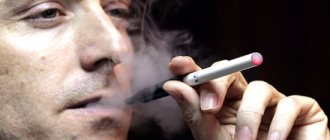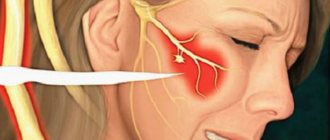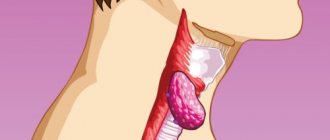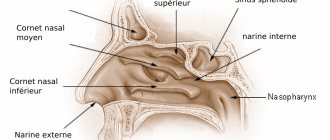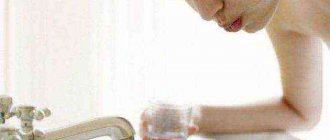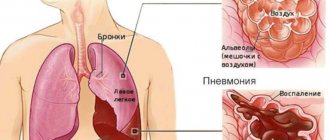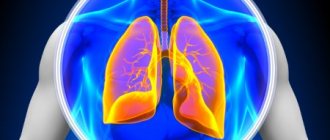Author of the article
Vereshchak Vladimir Vasilievich
Otolaryngologist (ENT) of the first category
Articles written
704
about the author
Inflammation of the inner ear, or labyrinthitis, is a rare but dangerous type of otitis media. It develops due to the entry of harmful microorganisms into the hearing organs. In some cases, it develops due to injury. When the first symptoms of the disease appear, you should immediately visit a doctor. If you ignore the disease, you can completely lose your hearing.
What is inflammation
Inflammation of the inner ear, although quite rare, is severe. The course of the disease can be compared with acute otitis media. The disease spreads to the labyrinth, consisting of three semicircular canals and the cochlea. The canals are responsible for the sense of balance, and the cochlea is responsible for hearing. Since the inner ear is located quite deep, the infection can enter through other sources of infection.
The disease develops against the background of otitis media. The middle and inner ear are separated by a membrane and through it the infection enters the inner ear. Pus forms there and pressure increases.
The infection can enter the labyrinth not only through the ear, but also through the membrane of the brain, due to meningitis. In this case, the infection affects both ears and causes complete deafness, especially in children. Injuring the ear with a needle or other foreign body increases the risk of inflammation. In some cases, labyrinthitis develops as a result of a blow to the temple or back of the head.
Inflammatory disease is also one of the complications:
- syphilis;
- flu;
- tuberculosis;
- mumps.
Other causes of the disease:
- catarrhal sinusitis;
- cold;
- allergic tonsillitis;
- alcoholism,
- neoplasms in the middle ear;
- overdose of medications.
Depending on the location of the inflammatory process, there are:
- purulent labyrinthitis;
- limited labyrinthitis.
Harmful bacteria and all their metabolic products enter the labyrinth during the course of the disease. Treatment of inflammation of the inner ear should begin when the first signs appear in adults and children.
Miner's disease
One of the variants of non-inflammatory ear diseases is Minière's disease. It affects the inner part of the ear. It is characterized by periodic dizziness, nausea and vomiting, tinnitus, problems with balance, and increased irritability. These signs appear in fits and starts. The cause of the pathology is diseases of individual internal organs, including allergies, menopause, and hormonal imbalances.
The main problem of the disease is a severe disorder of vestibular function. After the attack is over, the condition stabilizes, but there is still hearing loss and noise in the ears. Gradually the disease can progress. Most often, Minière's disease affects one ear, and there is no specific treatment for the pathology, only methods aimed at eliminating unpleasant symptoms. Bed rest is recommended. It is important to adhere to a diet with a minimum amount of salt and take foot baths with mustard.
Syabro powder is used to stop acute symptoms; antiemetic drugs can prevent vomiting. Usually, during the period of remission, electrophoresis, special physical exercises, and acupuncture are prescribed. Any bad habits are prohibited; try not to sunbathe or swim in deep water bodies. Sometimes surgical intervention using ultrasound or cryotherapy is proposed for treatment.
Symptoms of inflammation of the inner ear
Symptoms of the disease develop depending on the stage and course of inflammation. Main features:
- Hearing impairment. It appears suddenly. Sometimes hearing is completely lost.
- Pain and noise in the ears.
- Dizziness.
- Uncontrolled eye movements.
- Disturbance of equilibrium and balance.
- Increased sweating;
- Tachycardia.
The patient's condition worsens with head movements. And dizziness bothers me regularly and can even last for several hours. At the same time, the patient feels as if objects around him are rotating. This symptom is systemic in nature. To alleviate his condition, the patient lies motionless on his side, with the sore ear up. In the case of chronic labyrinthitis, the head may begin to spin suddenly and not stop for several days. Sometimes vomiting and nausea may occur. Non-systemic dizziness is characterized by:
- impaired coordination;
- instability when walking.
What else is dangerous about inflammation of the inner ear? Symptoms of the disease should be treated at the first sign. The disease can cause facial paralysis. Main signs of paralysis:
- increased secretion of saliva;
- change in taste;
- there are no folds on the forehead when the eyebrows are raised;
- complete immobility of the eyelids;
- unable to smile or frown;
- dry eyes.
These symptoms require immediate treatment.
From the auditory analyzer side, patients complain of ringing in the auricle due to ear inflammation and high-frequency noise. Hearing deterioration occurs over several days. Purulent labyrinthitis leads to complete deafness.
Non-drug treatment
However, even the most effective remedies cannot always cope with problems of the vestibular system. To reduce dizziness and improve coordination, special exercises are recommended. They can be performed at home after learning with medical staff. The most common types of rehabilitation exercises are:
- In a sitting position, then standing, fix your gaze on a stationary object and turn your head without taking your eyes off the selected point.
- Sitting on the edge of the bed, turn your head towards the sore ear and quickly lie down. After the symptoms of dizziness stop, you should sit down again, wait for the dizziness to stop and repeat the exercise in the other direction.
It is recommended to perform such exercises twice a day, gradually increasing their total duration to twenty repetitions (about half an hour) . In many cases, the symptoms of dizziness are significantly reduced after the first workout, and otitis media itself goes away much faster. However, if medications and restorative physiotherapy do not bring positive results, the ear must be treated surgically. Indications for this are purulent labyrinthitis and intracranial complications. Surgical intervention is aimed at:
- general sanitation of all parts of the ear;
- removal of abscess and necrotic tissue;
- cleaning the cochlea, its vestibule and circumferential canals.
Diagnosis of internal otitis
Inflammation inside the ear requires immediate medical attention. After talking with the patient and examining him, the otolaryngologist must make a diagnosis. What is included in the general inspection:
- examination of the eardrum;
- overview of the auricle and postauricular area;
It is also advisable for the patient to undergo a general blood test. For a more accurate diagnosis, which will show a holistic picture of the disease, the following methods are used:
- Audiometry. This is a study of auditory sensitivity to different frequency sounds. It is carried out by a specialist using an audiometer or tuning fork. An audiogram shows all hidden hearing impairments and ear diseases. This method has no contraindications or side effects. It is suitable for both adults and children.
- CT scan. Sequential X-ray scanning of human organs. Produces clearer, more detailed images than conventional x-rays. Contraindications: pregnancy and body weight more than 180 kg.
- MRI. It provides a more contrasting image than CT and the body does not experience ionizing radiation. Contraindications: pacemaker and middle ear implants.
- Electronystagmography is a study of the mobility of the eyeballs.
- Vestibulometry is a group of studies that provides complete information about the state of the vestibular apparatus.
To identify the causative agent of the disease, infected tissues are submitted for bacteriological analysis.
If it turns out that the inner ear has become inflamed due to otitis media, the doctor must select a treatment regimen and monitor the patient’s condition until he fully recovers.
Methods for diagnosing otitis
It is necessary to carry out a number of diagnostic procedures and examinations performed when visiting an ENT doctor. Diagnosis begins with identifying complaints and conducting an examination with the naked eye and using instruments - a reflector, otoscope, as well as studying the visible structures of the ear using an otoscope. Using instruments, they evaluate the condition of the auricle, the skin of the outer ear, cartilage and ear canal, as well as the visible part of the eardrum, determine the amount of wax and its color, and the presence of plugs.
Methods for assessing hearing and the condition of the eardrum are used (tympanometry with reflectometry); if there is purulent or other discharge, it is cultured and analyzed to identify pathogens and determine their sensitivity to antibiotics. If otitis is detected, treatment and symptoms are assessed and developed exclusively by a doctor; self-medication is unacceptable.
During the diagnostic process, it is important not only to identify inflammation, but also to determine its shape and location, which ear structures are affected, and whether there are complications and concomitant pathologies that may affect therapy.
Therapeutic treatment
After diagnosing labyrinthitis, the otolaryngologist prescribes an appropriate treatment regimen. In severe cases, the patient is hospitalized and treated in a hospital setting. If the disease is localized in one area and is not complicated by purulent masses, drug therapy is carried out. In addition, the patient needs rest and bed rest. The following procedures will be useful:
- diet - consume 1 liter of clean water per day and reduce salt intake (½ g);
- taking diuretics and hormones that increase blood glucose levels - glucocorticoids;
- internal injections of glucose, calcium chloride and magnesium sulfate;
- vitamin therapy: B, K, C, P;
- taking carboxylase.
If the labyrinth is filled with purulent masses and the entire inner ear is damaged, surgical intervention is performed. This happens when medications do not have any effect. The main goal of the operation is to remove purulent masses from the inner ear. After all, the inflammatory process is located dangerously close to the brain and poses a threat not only to the health, but also to the life of the patient. The type of operation depends on the course of the disease and the patient’s condition:
- Labyrinthotomy. Opening the semicircular canal of the labyrinth. Provides drainage of pus from the inner ear.
- Antomatoidotomy - trepanation of the mastoid process and removal of pus from there. It is performed under local anesthesia. Rehabilitation after surgery can last several months.
- Labyrinthectomy - surgical removal of the labyrinth. Used in rare cases.
If labyrinthitis has led to deafness, hearing aids or auditory surgery are prescribed.
Diagnosis and treatment
If the symptoms described above appear regularly, this is a reason for examination by an ENT specialist. In addition to examining the patient, the diagnosis of “internal otitis” is established based on examination using:
- audiometry, showing hearing acuity and the ability to distinguish tones;
- electronystagmography, which can determine the cause of dizziness by the type of movements of the eyeballs;
- magnetic resonance and computed tomography, which determine the presence of brain pathology;
- ABR - testing the brain's response to a sound stimulus.
In some cases, a consultation is carried out with a neurologist, neurosurgeon, dermatovenereologist, infectious disease specialist and other specialists. After establishing the diagnosis and the extent of damage to the inner ear, appropriate treatment is prescribed, which is carried out in a hospital. In most cases, it is recommended to treat labyrinthitis symptomatically, that is, use drugs that reduce the symptoms of this disease.
If labyrinthitis was caused by a bacterial infection, then antibiotics are prescribed in large doses, primarily Azithromycin and Ceftriaxone injections. Specific therapy for other types of pathogens is usually not carried out. According to indications, funds from such groups as:
- antihistamines (Betagistin, Suprastin, Diazolin, etc.);
- antiemetics (Cerucal, Phenegran, and Scopolamine patch);
- sedatives (Diazepam, Lorazepam, etc.);
- steroids (Medrol and other Prednisolone derivatives);
- diuretics (Furosemide).
Drug treatment
The treatment regimen is prescribed by the doctor depending on the individual characteristics of the body. If the disease is caused by a bacteriological infection, antibiotics are prescribed:
- II generation cephalosporins: Cefuroxime, Ceftin, Kefurox;
- III generation: Ceftriaxone, Tercef;
- IV generation: Maximim.
From the group of penicillins the following are prescribed:
- Oxacillin;
- Amoxicillin;
- Piperacillin.
For severe forms:
- Cifroploxacin;
- Cyprinol;
- Digital
To relieve inflammation in the inner ear, use:
- Diclofenac;
- Dicloran;
- Naklofen.
To eliminate nausea, vomiting and dizziness, take antihistamines:
- Suprastin;
- Tavegil;
- Diazolin;
- Fenistil.
To calm the nervous system:
- Diazepam;
- Lorazepam.
To improve blood circulation in the inner ear:
- Alfaserk;
- Betahistine;
- Betaserk.
If treatment is started on time, all functions of the inner ear will return to normal and hearing will be restored. To avoid a relapse, at the first manifestations of an ENT disease, you must consult a doctor.
Symptoms and causes
Symptoms of inner ear diseases, as well as the causes of infection, vary depending on the pathology. For correct and timely diagnosis, it is important to know the characteristic manifestations. And in order to avoid serious consequences, you should find out the root cause of the disease.
| Disease | Possible reasons | Main symptoms |
| Labyrinthitis |
|
|
| Meniere's syndrome |
|
|
| Sensorineural hearing loss |
|
|
| Otosclerosis |
|
|
As the diseases progress, the clinical picture increases, and new vestibular and neurological disorders are added.
Otosclerosis and hearing loss can develop slowly and are detected only at the last stage, when surgery and hearing aids are indispensable.
It is important to pay attention to the listed signs and not delay your visit to the otolaryngologist.
Physiotherapy
Physiotherapy is used to eliminate inflammation in the inner ear and improve blood circulation. What methods are used:
- Laser therapy. Low-intensity radiation is used for treatment. The laser penetrates deep into the tissue and reduces signs of inflammation and pain, enhances immune processes and restores the normal functioning of the diseased organ.
- Short-wave ultraviolet radiation (SWUV). Short rays have antiviral and bactericidal effects. Toxins and other harmful microorganisms are also destroyed. After a few hours, redness appears at the irradiation site, which disappears within 1-2 days.
- Transcranial electroanalgesia. A method of physiotherapy that involves applying a pulsed electric current to a sore spot. Effects: analgesic, sedative, regenerative.
- Galvinization or galvinic collar according to Shcherbak is the effect on the body of low voltage electric current. The method is contraindicated for malignant tumors, skin diseases, and cardiovascular diseases.
In case of labyrinthitis, UHF therapy and magnetic therapy cannot be used.
Is this procedure performed with contrast?
We often get questions about whether this procedure is performed using a contrast agent. In fact, if inflammation of the inner ear occurs or formations of a malignant or benign nature develop, then magnetic resonance imaging can indeed be performed with contrast. Thus, specialists will be able to not only identify the presence of a problem, but also study it, which is especially important in oncology. It is also important to be able to determine whether the inflammatory process has spread to neighboring tissues or even organs.
It is worth noting that the contrast agent has its contraindications, here are the main ones:
- individual intolerance to any contrast components;
- disorders associated with kidney function, and especially renal failure;
- liver failure;
- diabetes mellitus and other serious diseases.
Note! Of course, a contrast agent extremely rarely causes allergic reactions, but if the examination is planned, then it is best to get tested in advance for the presence or absence of an allergy; the attending physician will explain the details of this process to you.
Folk remedies to help
It is impossible to cure labyrinthitis using folk recipes. Alternative medicine can only enhance the effect of basic drugs. Also, “grandmother’s” methods are used to relieve symptoms of the disease:
- Dilute honey or propolis tincture in proportions 1:1 with filtered warm water. Place 2 drops in the ear.
- Mix freshly squeezed onion juice with vegetable oil in equal proportions. Wet a tampon in the resulting mixture and insert it into the sore ear. Can be left overnight.
- Pour medicinal burnet (2 tablespoons) with two glasses of boiling water. Leave for half an hour. Take a tablespoon orally three times a day.
These folk recipes can only be used under the supervision of a doctor. Herbal decoctions and herbal teas made from echinacea, rose hips, lemon balm and chamomile will be useful. Under no circumstances should warming procedures be performed. This can cause pus to spread to healthy tissue.
Prognosis and possible consequences of the disease
Inflammation of the inner ear often occurs as a complication of colds and infectious diseases, such as:
- pneumonia;
- measles;
- flu;
- tuberculosis;
- scarlet fever.
If inflammation is detected in time and the necessary medical assistance is provided, all auditory and vestibular functions will be restored. But if you ignore the signs of the disease, the consequences of otitis media are quite severe:
- inflammation of the facial nerve;
- mastoiditis - inflammation of the mastoid process at the temporal bone;
- osteomyelitis of the apex of the temporal bone;
- meningitis;
- encephalitis;
- sepsis;
- cerebral thrombosis;
- hearing loss;
- intracranial abscesses.
If treatment is started at an early stage, all symptoms and disorders will disappear. Otherwise, the patient may lose his hearing and health.
Prevention of inflammation
To protect yourself from labyrinthitis, you need to treat all infectious diseases in a timely manner and prevent them from becoming chronic. This mainly concerns otitis media. You should also avoid injuring the temporal region and regularly check the eardrum for damage. Since inflammation of the inner ear is almost asymptomatic, for prevention purposes it is necessary to regularly visit an otolaryngologist. To generally improve the condition of the body and strengthen the immune system, simple well-known rules will help:
- consumption of foods rich in vitamins and microelements;
- sports and regular physical activity;
- daily walks in the fresh air;
- maintaining cleanliness and microclimate in the room;
- timely treatment of respiratory infections;
- for chronic diseases - annual visits to medical sanatoriums.
These recommendations will help to significantly reduce the risk of diseases of the ENT organs, including labyrinthitis.
How to treat otitis media
Acute otitis media is most common in children, although adults can also suffer from it, in whom the disease can be chronic with periods of exacerbations. Its occurrence is associated with the development of ARVI, influenza, or exacerbation of infectious and inflammatory processes in the nasopharynx. The disease has the nature of a complication, a secondary process against the background of a weakening of the general immune defense or a decrease in the local resistance of the mucous membranes. Hypothermia, improper ear care, chronic runny nose, and abuse of sprays and drops with vasoconstrictor substances contribute to the formation of otitis symptoms.
A common cause of otitis is the penetration of infection into the ear cavity by an ascending route - from the nasopharynx during ARVI or adenoiditis, sinusitis. Rarely, the introduction of microbes occurs through the blood or lymph flow from distant foci. In such a situation, otitis media can be treated either conservatively, through the use of local and systemic medications, or surgically, with the risk of pus breaking into the cranial cavity and unbearable pain.
Often acute otitis media is manifested by fever and general malaise against the background of sharp and severe pain in the ear area, on one side or on both sides at once. During the accumulation of fluid and swelling in the ear cavity, hearing decreases, especially severely at the peak of the process; with perforation of the membrane and outflow of pus, with adequate treatment, this symptom gradually disappears. In the absence of any medicinal measures, when using traditional methods, complications and permanent hearing loss may develop. Only a doctor can prescribe treatment for otitis media (inflammation of the middle ear).
First of all, broad-spectrum antibiotics are prescribed. In addition to them, ear drops with anti-inflammatory, analgesic and antiseptic effects are used.
If there is a threat of the process spreading, a breakthrough of pus into the cranial cavity, or there are special indications, the ENT doctor may resort to surgical treatment - puncturing the membrane (paracentesis) to drain pus from the tympanic cavity, while continuing all necessary therapeutic measures.
It is also worthwhile to dwell on dubious and dangerous recipes labeled “how to quickly cure otitis media” from the Internet or according to tips from the older generation. Doctors strongly discourage their practice, especially if there is a threat of perforation of the membrane or if there is a hole in it. Instilling various decoctions and tinctures, especially alcohol, and outdated medications into the ear threatens not only permanent hearing loss, but also the possibility of developing meningitis.
